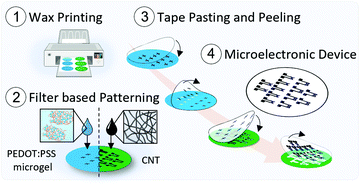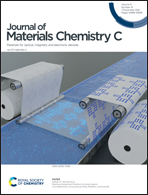Rapid prototyping of heterostructured organic microelectronics using wax printing, filtration, and transfer†
Abstract
Conducting polymers are the natural choice for soft electronics. However, the main challenge is to pattern conducting polymers using a simple and rapid method to manufacture advanced devices. Filtration of conducting particle dispersions using a patterned membrane is a promising method. Here, we show the rapid prototyping of various micropatterned organic electronic heterostructures of PEDOT:PSS by inducing the formation of microscopic hydrogels, which are then filtered through membranes containing printed hydrophobic wax micropatterns. The hydrogels are retained on the un-patterned, hydrophilic regions, forming micropatterns, achieving a resolution reaching 100 μm. We further solve the problem of forming stacked devices by transferring the acidified PEDOT:PSS micropattern using the adhesive tape transfer method to form vertical heterostructures with other micropatterned electronic colloids such as CNTs, which are patterned using a similar technique. We demonstrate a number of different heterostructure devices including micro supercapacitors and organic electrochemical transistors and also demonstrate the use of acidified PEDOT:PSS microstructures in cell cultures to enable bioelectronics.



 Please wait while we load your content...
Please wait while we load your content...